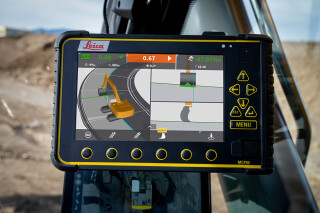New excavator models need to deliver in performance, safety, operator comfort, affordability and, increasingly, alternative power options.
In fact, fuel and power is a hot topic in the world of earthmoving equipment and all the major manufacturers are looking at the alternatives to diesel.
German manufacturer Liebherr is offering more options in its lineup to cater for customer expectations. For example, its new R 950 Tunnel crawler excavator now comes in an electric drive version: the R 950 Tunnel-E.
The R 950 Tunnel-E has a 100% electric power system that can be connected to the power supply directly with its own cable or via an optional cable reel. A battery-powered travel kit is available as an option, to allow ‘improved temporary mobility’ without a cable connection to the mains.
The water-cooled synchronous electric motor provides 150kW to 190kW of power. A water-cooled battery pack using nickel magnesium cobalt (NMC) technology (like a modern car battery) is available as an option. It has 64kWh energy capacity provided by two 32kWh batteries allowing 30 minutes’ travel at 2kph. The manufacturer says that, with the machine operating in cable mode, a battery pack at 20% charge takes just 2.5 hours to reach full charge.
Electric equipment is not itself a novelty in the tunnelling industry. Machines modified to work from remote generators or a mains supply via an umbilical power cable have been around for some time. But the new R 950 represents the latest refinement of the concept.
Environmentally, this machine provides zero emissions on site, as well as less risk of soil pollution usually caused by engine oil or fuel. The R 950 Tunnel-E has also been designed to produce less noise and heat, along with guaranteeing zero CO, CO2, NOX and particulate emissions, claims Liebherr.
Not all of Liebherr’s recent product launches are electric – not even in its tunnelling range. Alongside the all-electric R 950 Tunnel-E, last year saw the launch of a diesel-powered machine, the R 930 Tunnel. Replacing the R 924 Compact Tunnel, the new R 930 Tunnel’s boom is available in two lengths and is capable of swivelling through 45o to either side to allow the excavation profile to be followed.
This arrangement allows the operator to work from side to side without having to slew the superstructure, thereby reducing the risk of collision with construction site personnel or obstructions within the confines of the workspace. LED headlights are provided to illuminate underground spaces and extra protection is provided for the lights, cylinders and hoses.
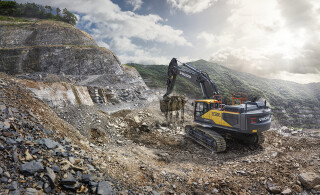
The R 950 has the option of a two- or three-tooth ripper bucket and a range of cutters and hammers to cover various applications. The grading blade allows the operator to level the site or to stabilise the machine when working on uneven rocky surfaces. It also protects the undercarriage and crawler drives against rubble.
The operator’s cab is designed to withstand dusty environments, with protection for its electrical components. Rear and side monitoring cameras ensure construction site safety, as well as being comfortable and ergonomic with easy-to-clean imitation leather seat and headrest.
More new earthmovers are slated for introduction later this year. Next month, Liebherr will launch the R 972 diesel crawler excavator at the Intermat construction equipment exhibition in Paris. The R 972 is the latest addition to Liebherr’s new range of 70-100 tonne machines announced at Bauma 2022 in Munich. The new generation of crawlers sees the previous models (R 966, R 970 SME, R 976 and R 980 SME) replaced with the R 972, R 978 SME, R 992 and R 998 SME.
Liebherr says the R 972 is ‘perfectly suited’ to the demands of bulk earthmoving or quarrying. It is powered by Liebherr’s own 330kW/449hp engine. It also has the company’s Bucket Fill Assist (BFA) system, which allows a higher bucket filling level, faster cycles, and better penetration into the digging material.
Operator comfort and safety are also key considerations and the cab has a ‘premium grade’ seat and FOPS protection grid. The BFA limits vibration in the cab as well as lowering fuel consumption by up to 10%, says Liebherr. It also has a 4.5m3 capacity backhoe bucket.
Liebherr’s Swedish rival Volvo Construction Equipment (Volvo CE) is also addressing the demand for electric power. Its most recent innovation is a mid-size electric excavator said to deliver the same performance as its conventional diesel counterpart but with the added benefit of zero emissions, low noise, low vibrations, better controllability and lower total cost of ownership.
The 23-tonne EC230 Electric was unveiled at a trade show in China in 2021 and subsequently launched in Norway in 2022. It is now commercially available throughout Europe. Volvo claims that it has not only been achieving a similar digging force as its diesel equivalent (the EC200E) but is doing so with a faster cycle time and less noise.
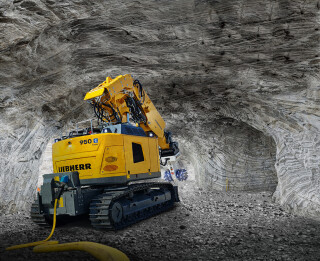
This machine is powered by lithium-ion batteries and has been designed to carry out a full eight hours of work on a single charge. It is the first of Volvo CE’s excavators in the mid-size range to be made electric and has recently been joined by the 20-tonne L120H Electric wheel loader.
Thomas Bitter, head of technology at Volvo CE, says: “The EC230 Electric has proven its sustainable power and is the perfect fit for modern construction sites – fulfilling demanding tasks while being considerate of its surrounding environment.”
Volvo CE entered a new size class in its excavator range in 2021 by launching not
one, but two 50 tonne diesel-powered machines with the EC530E and EC550E. Created for heavy duty digging, mass excavation and large-scale site preparation, the manufacturer claims that the machines deliver ‘digging and lifting forces normally found in 60 tonne machines’.
When coupled with large buckets, both models are suited to filling articulated haulers in the 30 to 40 tonne class – requiring fewer passes to load them, thereby reducing cycle times. This combination is said by the manufacturer to boost productivity by up to 20%.
These 50 tonne excavators have several characteristics of bigger machines including a rigid, reinforced undercarriage with the durability and strength normally associated with a 60-tonne excavator, and equally sturdy lower and upper frames. The boom and arm also boast a larger pin size for added strength.
The EC530E and EC550E are fitted with a low-emission Volvo D13J engine which, combined with Volvo’s electro hydraulics system can achieve up to 25% better fuel efficiency than comparable machines. Volvo says this is achieved through use of its independent metering valve technology (IMVT), which gives both more precise operation and efficiency than a traditional mechanically coupled hydraulic system.


Volvo says the new system offers a range of smart functions, including creep mode (useful for precise lift-and-carry work) and optional comfort drive control (CDC). CDC helps to reduce operator fatigue by allowing the excavator to be steered using the joystick rollers instead of the pedals.
Bill Kershaw, excavator product manager at Volvo CE, says: “We have seen a very high demand for excavators before and after Covid with more emphasis on machine control systems and hybrid technology, to increase efficiency and save fuel/CO2.”
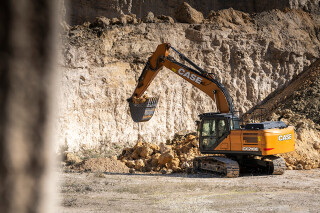
He added, “The house-building sector is seeing a softening this year, but infrastructure projects are keeping demand for larger excavators reasonably high.”
Also exhibiting at the Intermat exhibition next month Komatsu will be launching a 13-tonne electric excavator powered by lithium-ion batteries. It will be introduced to the Japanese rental market in 2024 and the manufacturer said a European launch would soon follow.
The PC138E-11 (an electric version of the PC138) will have a long-life battery with an advanced cooling system to prolong the life of both the battery and the electrical components.
Komatsu Europe has recently taken its range of reduced-tailswing wheeled excavators up to 20 tonnes with the launch of the PW168-11 and PW198-11.
The design’s short tailswing radius (1.85m on the PW168-11; 1.9m on the PW198-11) makes these machines ideal for use on for narrow construction sites, says Komatsu. The compact dimensions also make them easy to transport on a standard low-bed trailer.
The new machines are powered by 4-cylinder Komatsu diesel engines (110kW and 129kW respectively) and are shipped with hydrotreated vegetable oil (HVO) diesel substitute in the tanks as standard. HVO was briefly considered the magic bullet for environmentally-conscious machine users who wanted to switch from conventional fossil fuels. Being vegetable-based, they could clean up their environmental act without having to invest in new, unproven technology.
HVO reached the peak of its popularity two years ago in the run-up to the end of the red diesel rebate for construction users. It is still widely regarded as a ‘green’ alternative to conventional diesel fuel despite growing unease about HVO’s own sustainability and its role in deforestation.

Several major contractors and construction clients have since imposed a moratorium on HVO use on their sites until the fuel’s long-term sustainability claims have been verified.
Meanwhile, diesel technology continues to evolve for cleaner, more efficient operation demanded by ever-tightening environmental standards. And unlike the more exotic options such as battery power or hydrogen derivatives, diesel is still the most economical choice.
Case Construction Equipment’s latest diesel-powered machine is the CX210E-S, a 20-tonne class crawler excavator and the most recent addition to its E-Series line-up. As the alternative to the regular CX210E, the CX210E-S claims to offer all the performance, comfort, quality and reliability of the standard model but in a more basic package and at a lower price.
The machine is powered by a FPT NEF6 Stage V diesel engine and has a heavy-duty mono-boom and a single, equally heavy-duty 2.94m dipper arm option.
Case says that the CX210E-S comes factory-fitted with standard quick coupler circuit and high-flow multifunction auxiliary hydraulics, with a low-flow circuit also available for enhanced versatility with all kinds of attachments.
The E-S model is around 500kg heavier than the CX210E due to the beefed-up front-end equipment and lower structure and undercarriage. It can be boosted by another 500kg by selecting an optional counterweight to manage heavier attachments.
The 20-tonne sector remains one of the most competitive areas in the European crawler excavator market and Case is hoping that the pared-down configuration options and competitive pricing will make the CX210ES a popular choice, especially as these come with is no reduction in performance, quality or reliability, according to Case.
The new machine will be launching across Europe in the first quarter of 2024.
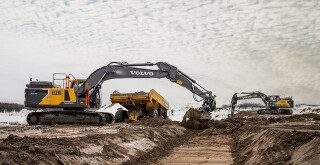
Expanded range of machine control for crawler excavators
Last year, Liebherr teamed up with Leica Geosystems to extend the range of semi-automatic machine control systems for its Generation 8 crawler excavator models. The systems are already available in different versions for Liebherr mobile and crawler excavators. They include the 2D passive and 3D passive machine control system for Generation 6 and 8, as well as the 2D ‘3D-ready’ semi-automatic and the 3D semi-automatic for Generation 6.
The availability of semi-automatic machine control systems, either 2D, ‘3D-ready’ or 3D, has been extended to Generation 8 crawler excavators: they are now available for the R 922, R 924, R 926, R 928, R 930, R 934, R 938 and R 945 models. The 2D ‘3D-ready’ passive machine control system is also offered for these models.
According to Liebherr, “The consistent use of sensors and software provides the operator with real-time information, which in turn enables work processes to be optimised in terms of time and costs thanks to various automation functions. In addition, the operator’s workload is reduced, which prevents driver fatigue and his or her associated susceptibility to errors.”
Got a story? Email news@theconstructionindex.co.uk


